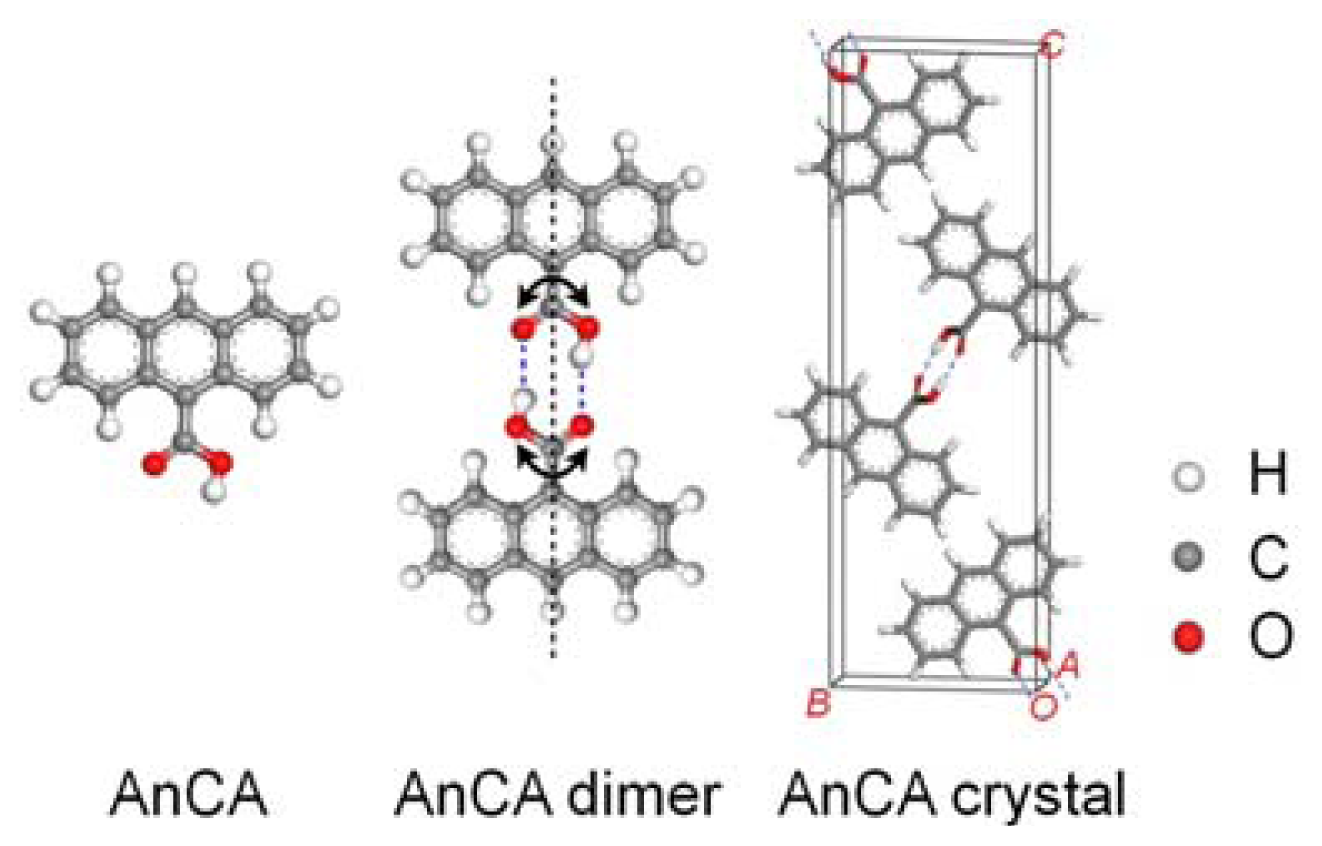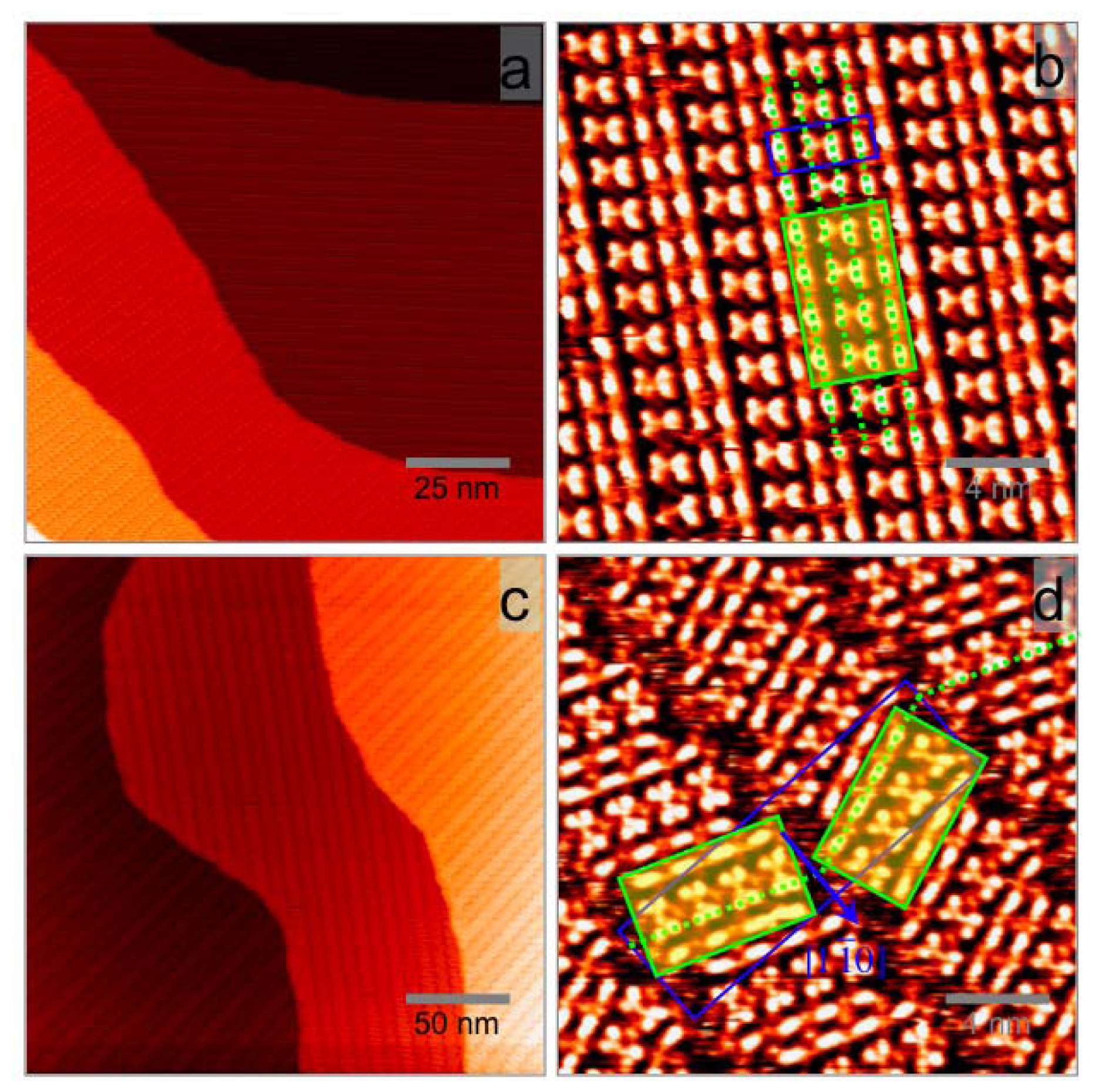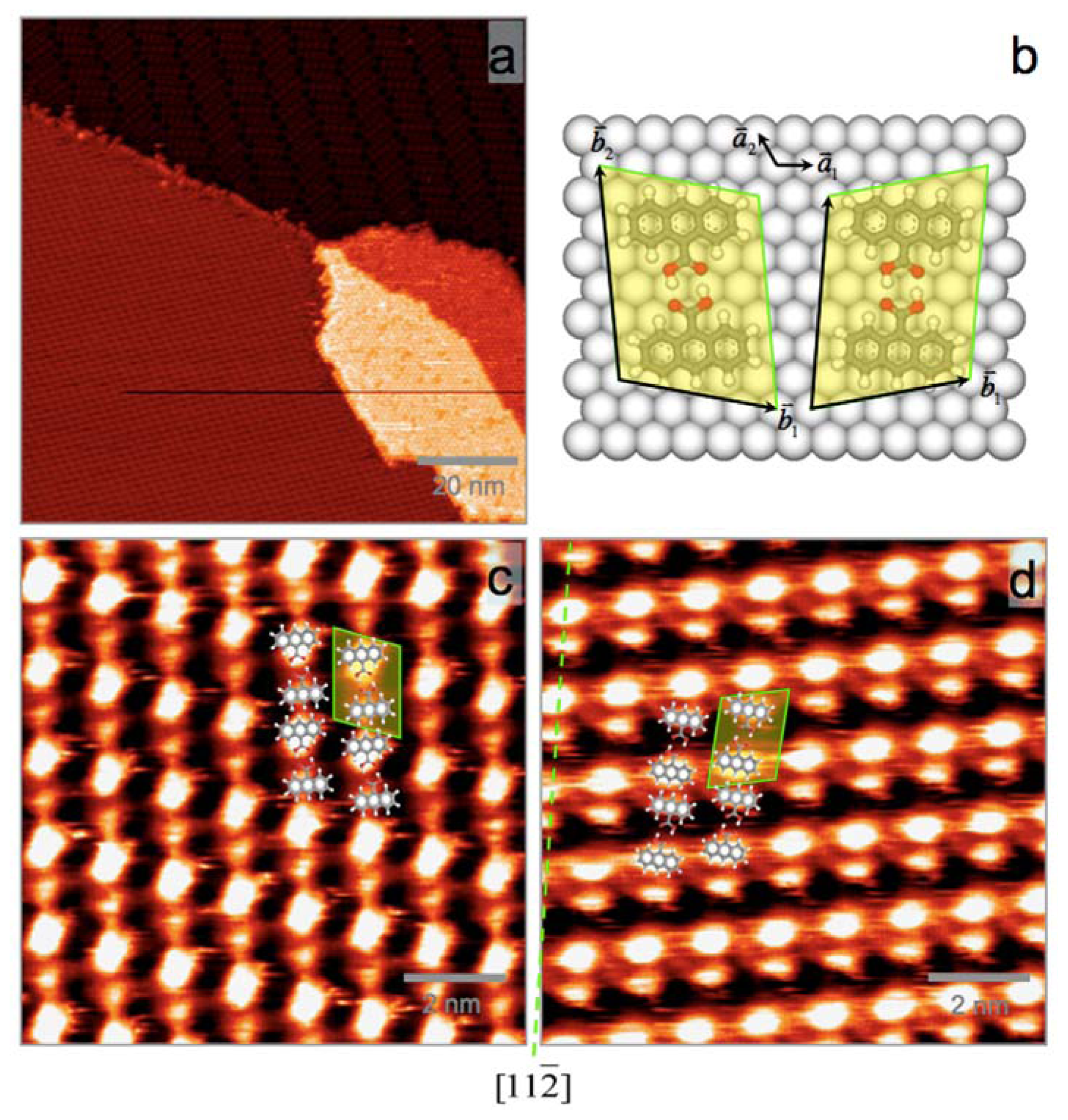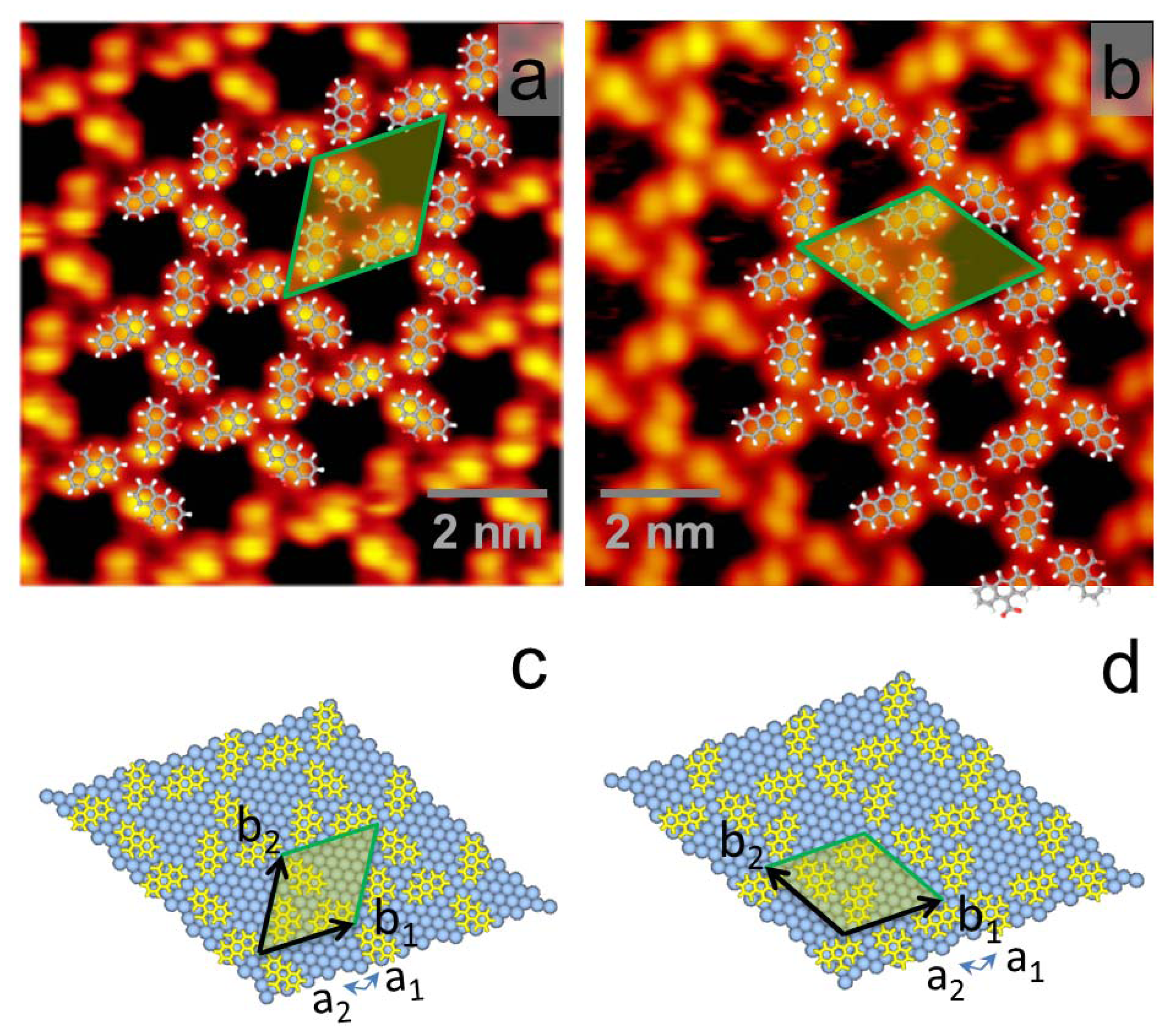Polymorphism in Self-Assembled Structures of 9-Anthracene Carboxylic Acid on Ag(111)
Abstract
:1. Introduction
2. Results and Discussion
2.1. Results
2.2. Discussion
2.2.1. Adlayer vs. Crystal
2.2.2. Evolution of AnCA Structures
2.2.3. Comparison with ACA
3. Experimental Section
4. Conclusions
Supplementary Information
ijms-13-06836-s001.pdfAcknowledgments
References
- Lehn, J.-M. Toward complex matter: Supramolecular chemistry and self-organization. Proc. Natl. Acad. Sci. USA 2002, 99, 4763–4768. [Google Scholar]
- Whitesides, G.M.; Boncheva, M. Beyond molecules: Self-assembly of mesoscopic and macroscopic components. Proc. Natl. Acad. Sci. USA 2002, 99, 4769–4774. [Google Scholar]
- Barth, J.V.; Costantini, G.; Kern, K. Engineering atomic and molecular nanostructures at surfaces. Nature 2005, 437, 671–679. [Google Scholar]
- Barth, J.V. Molecular architectonic on metal surfaces. Annu. Rev. Phys. Chem 2007, 58, 375–407. [Google Scholar]
- Otero, R.; Gallego, J.M.; de Parga, A.L.V.; Martín, N.; Miranda, R. Molecular self-assembly at solid surfaces. Adv. Mater 2011, 23, 5148–5176. [Google Scholar]
- Barth, J.V.; Weckesser, J.; Cai, C.Z.; Gunter, P.; Burgi, L.; Jeandupeux, O.; Kern, K. Building supramolecular nanostructures at surfaces by hydrogen bonding. Angew. Chem. Int. Ed 2000, 39, 1230–1234. [Google Scholar]
- Keeling, D.L.; Oxtoby, N.S.; Wilson, C.; Humphry, M.J.; Champness, N.R.; Beton, P.H. Assembly and processing of hydrogen bond induced supramolecular nanostructures. Nano Lett 2003, 3, 9–12. [Google Scholar]
- Theobald, J.A.; Oxtoby, N.S.; Phillips, M.A.; Champness, N.R.; Beton, P.H. Controlling molecular deposition and layer structure with supramolecular surface assemblies. Nature 2003, 424, 1029–1031. [Google Scholar]
- Dmitriev, A.; Spillmann, H.; Lin, N.; Barth, J.V.; Kern, K. Modular assembly of two-dimensional metal-organic coordination networks at a metal surface. Angew. Chem. Int. Ed 2003, 42, 2670–2673. [Google Scholar]
- De Oteyza, D.G.; Silanes, I.; Ruiz-Oses, M.; Barrena, E.; Doyle, B.P.; Arnau, A.; Dosch, H.; Wakayama, Y.; Ortega, J.E. Balancing intermolecular and molecule-substrate interactions in supramolecular assemblies. Adv. Funct. Mater 2009, 19, 259–264. [Google Scholar]
- Bonifazi, D.; Kiebele, A.; Stohr, M.; Cheng, F.; Jung, T.; Diederich, F.; Spillmann, H. Supramolecular nanostructuring of silver surfaces via self-assembly of [60]fullerene and porphyrin modules. Adv. Funct. Mater 2007, 17, 1051–1062. [Google Scholar]
- Yokoyama, T.; Yokoyama, S.; Kamikado, T.; Okuno, Y.; Mashiko, S. Selective assembly on a surface of supramolecular aggregates with controlled size and shape. Nature 2001, 413, 619–621. [Google Scholar]
- Eremtchenko, M.; Schaefer, J.A.; Tautz, F.S. Understanding and tuning the epitaxy of large aromatic adsorbates by molecular design. Nature 2003, 425, 602–605. [Google Scholar]
- Rosei, F.; Schunack, M.; Naitoh, Y.; Jiang, P.; Gourdon, A.; Laegsgaard, E.; Stensgaard, I.; Joachim, C.; Besenbacher, F. Properties of large organic molecules on metal surfaces. Prog. Surf. Sci 2003, 71, 95–146. [Google Scholar]
- Stadler, C.; Hansen, S.; Kroeger, I.; Kumpf, C.; Umbach, E. Tuning intermolecular interaction in long-range-ordered submonolayer organic films. Nat. Phys 2009, 5, 153–158. [Google Scholar]
- Buchner, F.; Comanici, K.; Jux, N.; Steinrueck, H.-P.; Marbach, H. Polymorphism of porphyrin molecules on Ag(111) and how to weave a rigid monolayer. J. Phys. Chem. C 2007, 111, 13531–13538. [Google Scholar]
- Plass, K.E.; Kim, K.; Matzger, A.J. Two-dimensional crystallization: Self-assembly, pseudopolymorphism, and symmetry-independent molecules. J. Am. Chem. Soc 2004, 126, 9042–9053. [Google Scholar]
- Xu, B.; Tao, C.G.; Williams, E.D.; Reutt-Robey, J.E. Coverage dependent supramolecular structures: C60:ACA monolayers on Ag(111). J. Am. Chem. Soc 2006, 128, 8493–8499. [Google Scholar]
- Wintjes, N.; Hornung, J.; Lobo-Checa, J.; Voigt, T.; Samuely, T.; Thilgen, C.; Stohr, M.; Diederich, F.; Jung, T.A. Supramolecular synthons on surfaces: Controlling dimensionality and periodicity of tetraarylporphyrin assemblies by the interplay of cyano and alkoxy substituents. Chem. Eur. J 2008, 14, 5794–5802. [Google Scholar]
- Wei, Y.Y.; Robey, S.W.; Reutt-Robey, J.E. Flux-selected titanyl phthalocyanine monolayer architecture on Ag(111). J. Phys. Chem. C 2008, 112, 18537–18542. [Google Scholar]
- Roos, M.; Hoster, H.E.; Breitruck, A.; Behm, R.J. Coverage dependent structures of oligopyridine adlayers on (111) oriented Ag films. Phys. Chem. Chem. Phys 2007, 9, 5672–5679. [Google Scholar]
- Barth, J.V.; Weckesser, J.; Trimarchi, G.; Vladimirova, M.; de Vita, A.; Cai, C.Z.; Brune, H.; Gunter, P.; Kern, K. Stereochemical effects in supramolecular self-assembly at surfaces: 1-D versus 2-D enantiomorphic ordering for PVBA and PEBA on Ag(111). J. Am. Chem. Soc 2002, 124, 7991–8000. [Google Scholar]
- Stohr, M.; Wahl, M.; Galka, C.H.; Riehm, T.; Jung, T.A.; Gade, L.H. Controlling molecular assembly in two dimensions: The concentration dependence of thermally induced 2D aggregation of molecules on a metal surface. Angew. Chem. Int. Ed 2005, 44, 7394–7398. [Google Scholar]
- Walch, H.; Dienstmaier, J.; Eder, G.; Gutzler, R.; Schlögl, S.; Sirtl, T.; Das, K.; Schmittel, M.; Lackinger, M. Extended two-dimensional metal–organic frameworks based on thiolate–copper coordination bonds. J. Am. Chem. Soc 2011, 133, 7909–7915. [Google Scholar]
- Müller, K.; Kara, A.; Kim, T.; Bertschinger, R.; Scheybal, A.; Osterwalder, J.; Jung, T. Multimorphism in molecular monolayers: Pentacene on Cu(110). Phy. Rev. B 2009, 79, 245421. [Google Scholar] [Green Version]
- Barlow, S.M.; Raval, R. Complex organic molecules at metal surfaces: Bonding, organisation and chirality. Surf. Sci. Rep 2003, 50, 201–341. [Google Scholar]
- Hooks, D.E.; Fritz, T.; Ward, M.D. Epitaxy and molecular organization on solid substrates. Adv. Mater 2001, 13, 227–241. [Google Scholar]
- Xu, B.; Zhu, E.; Lu, C.; Liu, Y.; Liu, Z.; Yu, D.; He, J.; Tian, Y. Distinct C60 growth modes on anthracene carboxylic acid templates. Appl. Phys. Lett. 2010, 96, 143115:1–143115:3. [Google Scholar]
- Xu, B.; Tao, C.G.; Cullen, W.G.; Reutt-Robey, J.E.; Williams, E.D. Chiral symmetry breaking in two-dimensional C60-ACA intermixed systems. Nano Lett 2005, 5, 2207–2211. [Google Scholar]
- Xu, B.; Varughese, B.; Evans, D.; Reutt-Robey, J. Morphology selected molecular architecture: Acridine carboxylic acid monolayers on Ag(111). J. Phys. Chem. B 2006, 110, 1271–1276. [Google Scholar]
- Fitzgerald, L.J.; Gerkin, R.E. Anthracene-9-carboxylic acid. Acta Crystallogr. C 1997, 53, 71–73. [Google Scholar]
- Tautz, F.S. Structure and bonding of large aromatic molecules on noble metal surfaces: The example of PTCDA. Prog. Surf. Sci 2007, 82, 479–520. [Google Scholar]
- Fernandez-Torrente, I.; Monturet, S.; Franke, K.J.; Fraxedas, J.; Lorente, N.; Pascual, J.I. Long-range repulsive interaction between molecules on a metal surface induced by charge transfer. Phys. Rev. Lett. 2007, 99, 176103:1–176103:4. [Google Scholar]
- Carter, C.B.; Hwang, R.Q. Dislocations and the reconstruction of (111) FCC metal surfaces. Phy. Rev. B 1995, 51, 4730–4733. [Google Scholar]
- Ling, W.L.; Hamilton, J.C.; Thurmer, K.; Thayer, G.E.; de la Figuera, J.; Hwang, R.Q.; Carter, C.B.; Bartelt, N.C.; McCarty, K.F. Herringbone and triangular patterns of dislocations in Ag, Au, and AgAu alloy films on Ru(0001). Surf. Sci 2006, 600, 1735–1757. [Google Scholar]
- Barth, J.V.; Brune, H.; Ertl, G.; Behm, R.J. Scanning tunneling microscopy observations on the reconstructed Au(111) surface: Atomic structure, long-range superstructure, rotational domains, and surface defects. Phy. Rev. B 1990, 42, 9307–9318. [Google Scholar]
- Huang, K.G.; Gibbs, D.; Zehner, D.M.; Sandy, A.R.; Mochrie, S.G.J. Phase behavior of the Au(111) surface: Discommensurations and kinks. Phys. Rev. Lett 1990, 65, 3313–3316. [Google Scholar]
- Oison, V.; Koudia, M.; Abel, M.; Porte, L. Influence of stress on hydrogen-bond formation in a halogenated phthalocyanine network. Phys. Rev. B 2007, 75, 035428:1–035428:6. [Google Scholar]
- Payer, D.; Comisso, A.; Dmitriev, A.; Strunskus, T.; Lin, N.; Wöll, C.; Devita, A.; Barth, J.V.; Kern, K. Ionic hydrogen bonds controlling two-dimensional supramolecular systems at a metal surface. Chem. Eur. J 2007, 13, 3900–3906. [Google Scholar]
- Tait, S.L.; Wang, Y.; Costantini, G.; Lin, N.; Baraldi, A.; Esch, F.; Petaccia, L.; Lizzit, S.; Kern, K. Metal-organic coordination interactions in Fe-terephthalic acid networks on Cu(100). J. Am. Chem. Soc 2008, 130, 2108–2113. [Google Scholar]
- Hahn, J.R.; Kang, H.S. Role of molecular orientation in vibration, hopping, and electronic properties of single pyridine molecules adsorbed on Ag(110) surface: A combined STM and DFT study. Surf. Sci 2010, 604, 258–264. [Google Scholar]
- Dougherty, D.B.; Lee, J.; Yates, J.T. Role of conformation in the electronic properties of chemisorbed pyridine on Cu(110): An STM/STS study. J. Phys. Chem. B 2006, 110, 11991–11996. [Google Scholar]
- Li, H. N-Heteroaromatic Acid Adlayer Structures under Hydrogen Bonding Influent: A Comprehensice UHV-STM/XPS/RAIRS Study. Ph.D. Dissertation, Univeristy of Maryland, College Park, MD, USA, 2007. [Google Scholar]
- Baski, A.A.; Fuchs, H. Epitaxial-growth of silver on mica as studied by AFM and STM. Surf. Sci 1994, 313, 275–288. [Google Scholar]





| Structure | Phase I | Phase II | Phase III | Phase IV | Phase V |
|---|---|---|---|---|---|
| a (nm) | 1.6 | 4.3 | 1.32 | 2.02 | 2.26 |
| b (nm) | 4.0 | 14.0 | 1.76 | 2.65 | 2.26 |
| α (°) | ~90 | ~90 | 74 | 71 | 60 |
| Density (mol/nm2) | 1.25 | 1.06~1.25 | 0.9 | 0.79 | 0.68 |
© 2012 by the authors; licensee Molecular Diversity Preservation International, Basel, Switzerland. This article is an open-access article distributed under the terms and conditions of the Creative Commons Attribution license (http://creativecommons.org/licenses/by/3.0/).
Share and Cite
Lu, C.; Wei, Y.; Zhu, E.; Reutt-Robey, J.E.; Xu, B. Polymorphism in Self-Assembled Structures of 9-Anthracene Carboxylic Acid on Ag(111). Int. J. Mol. Sci. 2012, 13, 6836-6848. https://doi.org/10.3390/ijms13066836
Lu C, Wei Y, Zhu E, Reutt-Robey JE, Xu B. Polymorphism in Self-Assembled Structures of 9-Anthracene Carboxylic Acid on Ag(111). International Journal of Molecular Sciences. 2012; 13(6):6836-6848. https://doi.org/10.3390/ijms13066836
Chicago/Turabian StyleLu, Chao, Yinying Wei, Erkuang Zhu, Janice E. Reutt-Robey, and Bo Xu. 2012. "Polymorphism in Self-Assembled Structures of 9-Anthracene Carboxylic Acid on Ag(111)" International Journal of Molecular Sciences 13, no. 6: 6836-6848. https://doi.org/10.3390/ijms13066836





